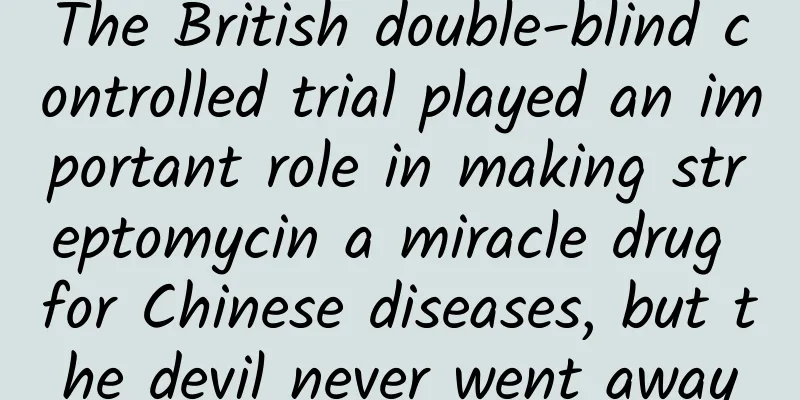The British double-blind controlled trial played an important role in making streptomycin a miracle drug for Chinese diseases, but the devil never went away

|
One day in 1946, 28-year-old Londoner John walked into Brompton Hospital, the largest lung hospital in the UK. Before that, John had been suffering from a low-grade fever for several days, night sweats, and coughing all day long. What was even more frightening was that there was blood in the sputum he coughed up. After the examination, the doctor told him with certainty: You have advanced tuberculosis. Before John could fully react, the doctor handed him an envelope and told him: Take this envelope to the inpatient department to complete the formalities. John took the envelope and coughed violently again. Advanced tuberculosis is like a death notice. He stared at the envelope in silence. On the envelope was written "Brompton Hospital" and a series of numbers, which looked like a series of random numbers. He opened the envelope and found a card inside with the letter "S" in bold. Looking at this strange card, John felt a glimmer of hope, but the doctor told him not to ask any more questions and to go directly to the inpatient department. John got up and left, with extremely complicated emotions, of course, fear and worry, but his strong desire to survive made him full of fantasies about this card. He didn't know what the letter S on this card meant, so he could only guess at various possibilities. John’s fear came from the mortality rate of this terrible disease. Even in modern times, according to data from the World Health Organization [1], tuberculosis is one of the top ten causes of death worldwide and the number one killer among single infectious diseases. It exists in all countries and all age groups. Moreover, this disease is highly contagious. When a tuberculosis patient coughs, sneezes or spits, the disease is easily spread. The lifetime risk of a person infected is 5-15%. However, once the disease occurs, if it is not properly treated, the mortality rate exceeds 45%. It is conceivable that in the 1940s, when there was no specific medicine, if you knew you had tuberculosis, you would feel the same as if you were diagnosed with advanced cancer today. Royal Brompton Hospital White Plague What kind of disease is tuberculosis? What is its pathogenesis? It is a very old disease, dating back to 2400 BC [2]. The spinal fragments of ancient Egyptian mummies at that time clearly confirmed tuberculous corrosive lesions. So tuberculosis has a history of at least 4,000 years. The autopsy of the remains of Lady Xin Zhui unearthed in Mawangdui, Changsha, my country, confirmed that there were calcified spots left by tuberculosis on her left lung. This at least proves that tuberculosis was introduced to my country more than 2,000 years ago. In ancient my country, pulmonary tuberculosis was called "consumption" and had a very high incidence rate. There was a saying among the people that "nine out of ten people have tuberculosis", and tuberculosis was even called China's national disease. In the early days of the founding of the People's Republic of China, the tuberculosis infection rate in large cities was as high as 80% to 90%, and the incidence rate was 4,000 per 100,000, which means that one in every 25 people had tuberculosis[3]. It can be said that China is also a severely affected area of pulmonary tuberculosis. Lin Daiyu in "Dream of Red Mansions" probably had tuberculosis, judging by her symptoms. Throughout the work, we often read passages about Daiyu waking up in the middle of the night, sweating, and coughing up blood. Yes, the typical symptoms of tuberculosis are severe coughing, chest pain, coughing up blood or sputum, fever, night sweats, weakness, fatigue, loss of appetite, etc. Stills from the 1987 version of Dream of Red Mansions Many great Chinese and foreign writers died of tuberculosis, such as Keats, Chekhov, Kafka, Lu Xun and so on. Readers who love science must know that the famous wave equation in quantum mechanics was completed by Schrödinger during his convalescence after suffering from tuberculosis. Although it has a long history and spreads all over the world, people have never figured out how this disease occurred. They only vaguely know that it seems to be an infectious disease. In ancient Greece before Christ, Hippocrates believed that tuberculosis was a widespread disease and warned his students not to contact advanced patients. Italian medical works in the 17th century also mentioned that it was an infectious disease. However, these texts are somewhat helpful in preventing tuberculosis infection but are not helpful in treating it. In order to conduct a more in-depth study, in 1679, a doctor named Franciscus Sylvius dissected the bodies of the patients who had died of the disease. He found that the patients’ lungs had granular lesions, which were gray-white masses called nodules[4], but that was all he learned. Later in 1839, German doctor Johann Lukas Schonlein named the disease tuberculosis based on the characteristics of the nodules. Because of the white nodules, people also called this horrible infectious disease the white plague. White nodules Discovery of pathogens More than 20 years later, in 1865, French military doctor Jean-Antoine Villemin confirmed that tuberculosis could be transmitted from humans to cattle and then to rabbits. He speculated that this might be caused by microorganisms. There were many scientists who had the same guess as him. At that time, many scientists were trying to find the culprit, but no one could find and prove the real pathogen. It was not until 1881 that Robert Koch, a famous German bacteriologist, began to study the pathogen of tuberculosis. Koch became famous for discovering anthrax bacteria. This time, after countless staining tests, he finally saw the slender spindle-shaped bacteria in sample No. 271, so Koch named it tuberculosis bacteria. It was in the process of studying tuberculosis bacteria that Koch gradually formed the basic law to prove that a certain disease is caused by microorganisms. This is an extremely important achievement for modern medicine. This is the famous Koch's law. Koch won the Nobel Prize in Medicine or Physiology in 1905 for his discovery of tuberculosis bacteria. Stamp commemorating Koch's discovery of tuberculosis With the progress of research, the medical community has finally found the cause of tuberculosis. It turns out that it is the tuberculosis bacillus that is at work. It is a Gram-positive bacterium with a complex cell wall and a small rod-shaped structure. It is most likely to affect the lungs and produce tuberculosis. Of course, it is not limited to the lungs. The tuberculosis bacillus can also be transported through the blood or lymphatic system and spread to any part of the body, such as the large intestine, meninges, kidneys and even inside bones. Now that the cause of the disease has been found, you might think that all that remains is to eliminate the bacteria in a targeted manner. However, things are not as easy as imagined. Koch tried many methods and extracted a tuberculin, but ultimately failed. Baby's first vaccine If we regard the invasion of tuberculosis bacteria into the human body and cause tuberculosis as a battle to defend a city, one way to win is to fight back against the enemy after it is captured, but it would be a better way to resist the enemy before it is captured. This is the vaccine idea. The famous Pasteur Institute had a doctor of bacteriology named Albert Calmette. He met veterinarian Dr. Camille Guerin at an academic conference and invited him to work together. In 1901, Calmette opened the first tuberculosis clinic in Europe and embarked on the road of tuberculosis research. Albert Calmette (left) Camille Guerin (right) We have talked about the story of smallpox before. Dr. Edward Jenner produced vaccinia vaccine from cowpox, and after vaccination, people could be immune to human smallpox. Inspired by this, Kalme and Gelin also wanted to start research on bovine tuberculosis bacteria. However, the toxicity of bovine tuberculosis bacteria is relatively strong. This is exactly the opposite of the smallpox vaccinia vaccine. The smallpox vaccinia vaccine is less toxic, so it is safer as a vaccine. But the bovine tuberculosis bacteria cannot be used as a vaccine. It is too toxic and risky to use it as a vaccine. After all, these two people were capable people of the Pasteur Institute and had rich research experience. They soon came up with the idea of attenuating the toxicity through propagation (in short, let the tuberculosis bacteria continue to reproduce and propagate), hoping that they would change their characteristics during the reproduction process. If a certain trait can reduce the toxicity, it will be retained and continued to be propagated. In numerous experiments, they found that 5% ox bile glycerol potato was the most suitable culture medium, and with the increase in the number of generations, they could always screen out weaker strains. In 1921, they finally found the right strain, which had been passed down to the 231st generation. They proved the immune effect of the vaccine on guinea pigs and also confirmed the safety of the vaccine. Pasteur named the vaccine after the initials of their two names, which is BCG, and the Chinese name is BCG. After the advent of BCG, it saved countless children. For children born into tuberculosis families, the incidence of tuberculosis in the first year was reduced from 25% to 2%[5]. The effect was very significant. In fact, BCG is familiar to all of us. Newborn babies are normally vaccinated with BCG on the first day of birth. If you are ready at this moment, please raise your left arm. The round scar on your upper arm is the BCG vaccination certificate. BCG vaccination marks The introduction of BCG into my country was also a tortuous process. After Pasteur published the research results of BCG, a doctor named Wang Liang also noticed the paper [6]. When he returned from Hanoi, Vietnam, where he studied medicine, he learned that his brother and sister had died of tuberculosis. Therefore, he paid special attention to the progress of tuberculosis prevention and treatment. After reading the paper, he went to France in 1931 to find Dr. Calmey at the Pasteur Institute and learned the research and development and production technology of BCG. More than two years later, he returned to his motherland with the vaccine and began to vaccinate people in his own clinic in Chongqing. However, due to the turmoil of the year and the lack of official recognition at the time, his BCG was banned in 1937. Later, with the development of domestic biological product research, Liu Yongchun from the Pasteur Institute in Shanghai Concession and Tang Feifan from the Central Epidemic Prevention Office gradually introduced BCG strains again. In any case, BCG was widely used in China. However, just when people thought that the vaccine could cure all diseases like the smallpox vaccine, more and more facts proved that the protective effect of BCG was not perfect[7]. It was very effective in protecting against childhood meningitis and disseminated tuberculosis, with an average protection rate of 86%, which is comparable to the protection rate of most vaccines[8]. However, the protective effect in adults was not obvious, and it could not prevent the recurrence of primary infection and latent lung infection. Finding a specific drug to treat tuberculosis remains a medical challenge to be solved. Unveiling antibiotics: Streptomycin Selman Abraham Waksman of Rutgers University in the United States is a famous soil scientist. In 1915, when he was in college, he began to study soil microorganisms and extracted a gray actinomycete with his classmates. Selman Waxman (Photo by Tarza Studio, New Brunswick, New Jersey) At that time, people found that if tuberculosis bacteria fell into the soil, they would be killed quickly. So, is there any microorganism or substance in the soil that can resist tuberculosis bacteria? In 1932, Professor Waksman was commissioned by the American Anti-Tuberculosis Association to study this issue. Inspired by Fleming's penicillin extracted from Penicillium, he set out to look for antibacterial substances from actinomycetes. In 1939, he also received funding from Merck. By 1941, Waksman and his team had studied more than 8,000 bacterial species and discovered various bacteriocins. In 1943, his student Albert Schatz extracted a new bacteriocin from Actinomycetes griseus and named it streptomycin. The word antibiotic also appeared in this process. If Fleming's penicillin was the first step to the discovery of antibiotics, then Waksman was the one who truly unveiled the curtain on antibiotics[9]. Streptomyces griseus In 1944, Waksman gave streptomycin to the Mayo Clinic for research. As expected, this streptomycin showed many excellent properties, which can fight many kinds of bacteria, including Mycobacterium tuberculosis, and complement the effects of penicillin. They used streptomycin on guinea pigs with tuberculosis, and found that 16 lesions had subsided after 6 months of continuous treatment. 30% of the guinea pigs could not detect Mycobacterium tuberculosis by histological and bacteriological methods, and the remaining 70% of the disease was also contained. In human trials, at least 16 of the 21 patients with pulmonary tuberculosis showed significant improvement in their condition after using streptomycin for 4 weeks. The emergence of streptomycin was a big deal. On the one hand, it showed a strong bactericidal ability. The killing effect of soil on tuberculosis bacteria was the contribution of streptomycin. On the other hand, due to the huge economic benefits brought by streptomycin, Schatz and Waksman even went to court to fight for the right of discovery, which also indirectly confirmed how important the discovery of streptomycin was. In fact, the mechanism of action of streptomycin is to block the synthesis of proteins in infected cells, thereby inhibiting the reproduction of Mycobacterium tuberculosis. Waksman won the Nobel Prize in Medicine or Physiology in 1952 for his contribution to the discovery of streptomycin. Austin randomized double-blind trial When this news reached the UK, it brought great excitement to the medical community. But in the view of Austin Bradford Hill, a professor of medical statistics, this was far from enough. Doctors at the time had already discovered the human body's self-healing and placebo effect. Some medical scientists with rigorous scientific thinking had realized that if they wanted to prove that a drug was effective, they had to eliminate these interfering factors. And the only way to eliminate these interfering factors was to conduct a randomized double-blind controlled trial. Austin Bradford Hill In 1946, the British Medical Research Council (MRC) planned to conduct clinical trials on streptomycin[10][11]. They ordered 50 grams of streptomycin from the United States, and Austin became a member of the committee. This was also the first rigorous randomized double-blind controlled trial (RCT) in medical history, which was of great pioneering significance.[12] Considering the limited amount of streptomycin, the experiment he designed was arranged as follows: select those tuberculosis patients aged 15 to 30 years old, who must be newly infected with acute progressive bilateral tuberculosis and are not suitable for collapse therapy. (Colapse therapy is a treatment method of artificially injecting clean air into the chest or abdominal cavity, which can selectively shrink the diseased lung.) If there are patients who meet the conditions, they will be sent to the head of the National Coordinating Center. After judging that they meet the standards, they will arrange a bed nearby and assign an envelope with a random number, which will contain a card marked "S" or "C". S is actually the first letter of Streptomycin; and C means control group. If they are in the same hospital, the two groups of people cannot be arranged in the same ward to prevent mutual communication. John, the man we mentioned at the beginning of our story, was fortunately randomly assigned to Group S. In fact, both Group S and Group C received standard medical treatment and bed rest at the time. The only difference was that Group S received additional streptomycin. There were 55 patients assigned to Group S like him, and 52 patients in Group C as a control. John had chest X-rays taken every month to assess his progress, and regularly recorded physiological indicators such as fever, weight, and sedimentation rate. The doctors who performed the chest X-rays were also completely unaware of the grouping, which prevented the results from being biased. Half a year passed, and when the results of the experiment were evaluated, there were only 4 deaths in Group S, while there were 15 deaths in Group C. Streptomycin showed a significant effect. Soon, Merck began to mass-produce streptomycin, which played an important role in the treatment of tuberculosis. Data map: Streptomycin produced by Merck in the 1940s was used to treat tuberculosis Let me make it clear that the control group did not mean giving up treatment, and they were not treated unfairly. The treatment they received was still the most standard treatment at the time, and for patients in the control group, the coordination center gave them priority admission. And once streptomycin is proven to be effective, they will receive new drug treatment after the drug supply is improved, and they can also avoid the unknown side effects of new drugs. Therefore, there is no problem in medical ethics. Unfortunately, streptomycin is not a miracle drug. Although the data show significant effects, its side effects are gradually emerging. It can damage the vestibular nerve and cochlear nerve, and in severe cases can cause permanent hearing loss. It is also toxic to the kidneys. Of course, we should choose the lesser of two evils, and saving lives is the most important thing. However, some patients will still develop resistance to streptomycin. This makes streptomycin treatment only harmful to some people. Tuberculosis drug resistance and current status In the 1950s and 1960s, isoniazid, pyrazinoyl, ethambutol, and rifampicin were successfully developed, and their alternating or combined use can greatly reduce the incidence of drug resistance in tuberculosis. These drugs have been used until now and have become the first-line drugs against tuberculosis. By the 1980s, the incidence of tuberculosis in industrialized countries had begun to decline steadily. In the United States, for example, the number of cases per year dropped from 28,000 in 1980 to 22,000 in 1984.[13] Given this trend, it was generally believed that tuberculosis would no longer be a threat to public health. However, just when people saw the dawn of victory, many countries reduced funding for tuberculosis control, and as a result, the situation began to deteriorate again. By 1992, the number of cases in the United States had risen back to more than 26,000. The entire 1980s showed a U-shaped curve. From 1980 to 2000, the incidence rate in some sub-Saharan African countries increased from 50 per 100,000 to more than 200 per 100,000, and Zimbabwe even reached 400 per 100,000, an increase of 8 times; the former Soviet member states also increased from 40 per 100,000 in 1991 to about 70 per 100,000 in 2000. At the same time, drug resistance of Mycobacterium tuberculosis has become more and more common, and drug-resistant tuberculosis has emerged. A study in 1993 showed that drug-resistant and multidrug-resistant cases in New York accounted for 23% and 7% respectively. Multidrug resistance here means resistance to the two first-line drugs, isoniazid and rifampicin. In this case, second-line drugs need to be selected for treatment. Picture of tuberculosis patients on WHO official website In 1993, WHO declared tuberculosis a "global emergency" in order to intensify efforts to control the spread of tuberculosis. Drug resistance has become the main obstacle to the elimination of tuberculosis. Following multidrug-resistant tuberculosis, extensively drug-resistant tuberculosis, which is resistant to second-line drugs, and "totally drug-resistant tuberculosis", which is ineffective against existing drugs, have emerged. The first cases of completely drug-resistant tuberculosis reported worldwide were two women in Italy, who died in 2003[14]. However, to date, due to the lack of data on resistance to second-line drugs and the inability to equate in vitro test results with actual clinical effects, the WHO has not yet recognized the term "totally drug-resistant"[15]. Globally, India and my country are the hardest hit by drug-resistant tuberculosis, with drug-resistant tuberculosis accounting for 14% in my country and 27% in India[16]. According to data published in the Global Tuberculosis Report updated on October 14, 2020[17], a total of 1.4 million people died from tuberculosis worldwide in 2019, there were an estimated 10 million new cases of tuberculosis, and the number of multidrug-resistant cases increased by 10% compared to 2018. However, the good news is that the incidence of tuberculosis has been declining by 2% each year, with a cumulative decline of 9% between 2015 and 2019. The situation in China has also improved significantly. From 2000 to 2019, the estimated number of cases decreased year by year, from 1.4 million to 833,000 [18], with an average annual decline rate of 2.7%. In May 2014, the 67th World Health Assembly released the Stop TB Strategy[19], which sets a vision of a world without tuberculosis, where tuberculosis no longer causes death, disease and suffering. By 2035, tuberculosis deaths will be reduced by 95% and cases by 90% compared to 2015, with no family facing catastrophic consequences from tuberculosis. Global Stop TB Strategy Targets 2035 This strategy was reaffirmed at the 2018 UN Conference and was supported by all member states. In this tortuous history of human fight against tuberculosis, I think the most historically significant one is Austin's randomized double-blind controlled trial. In my opinion, no matter how highly we evaluate the status of randomized double-blind controlled trials in the history of medicine, it is not excessive. "Evidence-based medicine", which is regarded as the new thinking of clinical medicine in the 21st century, is based on randomized double-blind controlled trials. I think that in the era without randomized double-blind controlled trials, medicine always has a taste of metaphysics. It is difficult to prove a definite causal relationship between medical treatment and disease recovery. However, when randomized double-blind controlled trials gradually entered the research paradigm of modern medicine, the scientific nature of medicine has become stronger and stronger, and medicine has gradually begun to get rid of the shadow of metaphysics. I sincerely hope that everyone can jump out of the daily logical trap and have more scientific thinking. Especially in medicine, stay away from those so-called folk remedies and legends that one medicine can cure all diseases. I also hope that everyone can overcome the emotional cognition of their own bodies and believe in the rational conclusions verified by the scientific community. Source https://www.who.int/en/news-room/fact-sheets/detail/tuberculosis International Council of Nurses, Tuberculosis Guidelines 3rd Edition, 2017: https://www.icn.ch/system/files/documents/2020-06/Chinese%20ICN%20TB%20MDR%20TB%20guidelines%202017%20full.pdf Jiang Yonghong, A Chronicle of China's Vaccine Centenary [M] Beijing: People's Publishing House, published in March 2020. Chapter 13 Li Liang, Li Qi, Xu Shaofa, et al., Tuberculosis Therapeutics [M] Beijing: People's Medical Publishing House, May 2013. Chapter 1 [M] Han Ruifa, et al., Principles and Practice of BCG Immunotherapy for Bladder Cancer, People's Medical Publishing House. Chapter 2 [J] Wang Liang, How I Got BCG Back from France. Tuberculosis Health Education, 1994https://www.who.int/immunization/BCG_Chinese.pdfNational Health Commission's "Vaccination Knowledge" "The protection rate of most vaccines is > 80%"http://www.nhc.gov.cn/wjw/jbyfykz/201604/0fe932715ccd494e99b68c0fc9bda0c5.shtmlZhang Qing, Wang Yufang, et al. A History of Natural Drug Chemistry: Streptomycin. Chinese Herbal Medicine vol. 49,761https://www.cnki.com.cn/Article/CJFDTotal-ZCYO201804001.htmhttps://www.ncbi.nlm.nih.gov/pmc/articles/PMC1592068/https://www.researchgate.net/profile/Ro berto_Bucci/publication/286618742_Public_health_and_medical_humanities_history_corner_Austin_Bradford_Hill_Simply_the_best/links/57065b4d08ae0f37fee1da5c.pdf https://www.ncbi.nlm.nih.gov/pmc/articles/PMC3149409/https://www.ncbi.nlm.nih.gov/pmc/articles/PMC3149409 https://www.sciencedirect.com/science/article/abs/pii/S1472979202000719https://www.wired.com/2012/01/tdr-first-italy/ https://www.eurosurveillance.org/content/10.2807/esw.12.20.03194-en) WHO: Totally drug-resistant tuberculosis FAQshttps://www.who.int/tb/areas-of-work/drug-resistant-tb/totally-drug-resistant-tb-faq/en/Global Tuberculosis Report Executive Summary 2019, p2, https://www.who.int/tb/publications/global_report/en/https://www.who.int/en/news-room/fact-sheets/detail/tuberculosisData are from the TB report App provided by WHO. Available for download at: https://www.who.int/teams/global-tuberculosis-programme/tb-reports https://www.who.int/tb/strategy/end-tb/en/ |
>>: How to relieve constipation? Try these 5 methods
Recommend
What are the fitness equipment for women to lose weight in the abdomen?
Many women find that they have a lot of fat on th...
Benefits of stair climbing for women
In modern society, people can exercise in a varie...
What are the folk remedies for treating a wasp sting? What should I do if the wasp sting causes swelling?
Wasps are also a kind of bee. They have a stinger...
Mycoplasma pneumonia infections are down, but this virus can also cause fever…
The topic "Recent children's fever may b...
How to reduce the big belly after childbirth?
I believe that many women will find that even aft...
What causes vaginal polyps?
In our lives, many women will feel stomach pain a...
Can pregnant women go swimming in the sea?
Almost everyone living in inland areas has a drea...
How to deal with cough caused by cold during pregnancy?
The immunity of pregnant women decreases to a cer...
Does drinking honey lemon water during pregnancy affect the fetus?
Pregnant women should be careful about the consum...
Scientific understanding of alum in food
Golden and crispy fried dough sticks are a common...
Always feel exhausted after dialysis? These 5 ways to help you regain your energy!
For many patients receiving dialysis treatment, a...
Is it normal to have irregular menstruation after weaning?
Many women will experience some physical changes ...
Menstruation is about to end and bleeding
In clinical medicine, some female friends will ex...
What are the advantages and disadvantages of eating hawthorn cake? How to make hawthorn cake with hawthorn
Hawthorn cake tastes sweet and sour, and contains...
When is the best season to eat lotus pods? How much lotus pods should be eaten at one time?
Lotus pods are a common food ingredient in southe...









